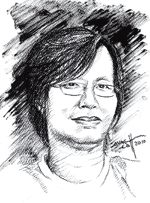
| By KYAW ZWA MOE | Tuesday, February 1, 2011 |
The current speculation about who will become Burma's next president, vice presidents and chairpersons of the houses of parliament is a ridiculous sideshow.
In most countries, finding out who will hold key government positions is normally helpful in sensing what the political landscape and climate might be. But Burma is a political climate-controlled country and only one man, junta chief Snr-Gen Than Shwe, is allowed to touch the dial.
Just look at what happened inside the country's first parliamentary sessions on Tuesday following the unannounced resignation of all junta ministers, including Prime Minister Thein Sein, from their previous government positions.
 |
| Kyaw Zwa Moe is managing editor of the Irrawaddy magazine. He can be reached at [email protected]. |
Then Khin Aung Myint, the former minister of culture, was just as easily elected as head of the Upper House (Nationalities' Parliament), which is also dominated by military and USDP representatives. The process, which was identical to that in the Lower House, will become routinely and nauseatingly familiar to all Burma watchers in the future: a USDP MP nominates a former junta minister to his new post, another USDP MP supports the nomination, and all USDP and military MP's vote in favor.
No surprises at all, just the way the puppet-master wants things run.
The next step is to elect three vice-presidents, and from that pool of junta operatives, elect a president. We received reports today that ex-prime minister and USDP representative Thein Sein, and Phalon Sawaw Democratic Party representative Saw Thein Aung, were nominated for the vice-presidential slot to be selected by the Lower House.
And for the Upper House's vice-presidential selection, Sai Mawk Kham, a USDP representative, and Aye Maung, the leader of Rakhine Nationalities Development Party, were nominated.
The military representatives, who make up 25 percent of both houses, are allowed to select the third vice-president, and they reportedly chose ex-General Tin Aung Mhyint Oo, the secretary-1 of the State Peace and Development Council, which is the junta's ruling body.
This means that of the five nominees for the three vice-presidential positions, a convenient three are also members of the USDP. Once again, no surprises. And this makes it easy to predict that Thein Sein, Tin Aung Myint Oo and Sai Mawk Kham, all USDP members, will ultimately be chosen as the three vice-presidents.
But the top question that Burmese journalists have raised and Burmese commentators have asked is: Who will be the president?
Most previous speculation centered around whether Than Shwe would engineer himself into the position. But since he chose not to make himself one of the vice-presidential nominees, he cannot become president. To predict who will nominally hold the position in his stead, however, is not difficult either: The “Oscar” will go to Thein Sein.
The 65-year-old ex-prime minister is considered the “international figure” among the ranks of regime leaders. Since 2007, when he was appointed PM, he has attended several summits of the Association of Southeast Asian Nations (Asean) and visited several Asean countries. During that same time, Than Shwe avoided such summits and regional meetings like the plague.
In fact, Than Shwe has seen Thein Sein as Burma's political “head of the state” since the time he appointed him prime minister. But that does not mean that Thein Sein ever had significant power in the old regime, or ever will have such power in the new government. It simply means that nothing at all has changed: Thein Sein will serve as Than Shwe's primary puppet going forward, just as he served in the past.
So the only question remaining is what position, if any, Than Shwe will chose to hold in the new government. Will he continue on as commaner-in-chief of the military, resign and wield power from behind the scenes, or truly retire and relinquish the power he has held for the past 19 years?
Maybe he will disappear completely, becoming a monk and spending his remaining years in mediatation in a belated attempt to atone for his multitude of sins!
Fat chance. Than Shwe has studied and learned a lot from the experiences of Indonesia's Suharto and South Korea's Chun Doo Hwan, both of whom faced charges after stepping down. He also knows full well what happened to Burma's very powerful and charismatic dictator Ne Win, who by Than Shwe's own hand counted down the days to his death while under house arrest.
Than Shwe will never put himself in a position to endure such a fate. He created Burma's entire current political structure from scratch, beginning with the National Convention, moving on to the Cyclone Nargis referendum, then forward to the rigged election and finally to the foregone conclusion of who will sit in the most powerful positions in the new government. And Than Shwe created it all for one purpose: to remain in power.
So what can we expect from Burma's new parliaments, president, vice-presidents and the rest of the government created by Than Shwe? Unfortunately, you know the answer: We will see the same old, same old in Burma.